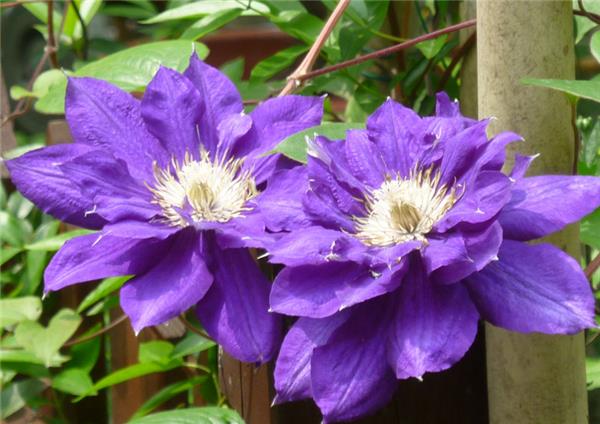Planting method of clematis
Clematis has always been known as the "queen of rattan flowers". There are many varieties and colors, and the flowers still have a faint aroma, which is very favored by people. Let's take a look at the planting method of clematis.

Planting method of clematis
Sowing, striping, grafting, dividing plants or planting and breeding can be done.
Sowing: the original seed can be cultured by sowing. Seeds of the type unearthed from cotyledons (achene is smaller and the pericarp is thinner) can germinate in 4 weeks if sown in spring. Sow in autumn and germinate when spring is warm. Cotyledon retained soil type seeds (larger, thicker seed coat) can only germinate after a low-temperature vernalization stage, and the first pair of true leaves are born; some species have to go through two low-temperature stages to germinate, such as rotator lotus. For vernalization treatment, if the seeds were refrigerated with 0Mel 3 ℃ for 40 days, it would take about 9-10 months for them to germinate. It can also be treated with a certain concentration of gibberellin.
Crimping: in March, use last year's mature branches to crimp. It usually takes root within a year.

Grafting: a hybrid of clematis that can be split onto C.vitalba or C.viticella rootstock by a single scion. There are 2 buds on the node and 5-10cm under the node. Grafting in a heated and airtight grafting box is easy to promote survival.
Ramet: tufted plant, which can be ramified.
Cunninghamia lanceolata: the cultivation variety of hybrid clematis takes the cuttings as the main culture method. The semi-mature branches were taken from July to August and intercepted in the middle of the internodes (that is, the upper and lower nodes), with 2 buds on the nodes. The medium is made of peat and sand in half. The depth of insertion is that the bud on the node has just exposed above. The base temperature is 15-18 ℃. After rooting, put up a 3-inch basin and spend the winter in an anti-freezing hotbed or greenhouse. Change the 5-inch basin in spring and move it out of the room. Shade and showers are needed in summer and planted at the end of October.

Culture methods of Clematis
1, soil: like fertile, well-drained alkaline loam, avoid stagnant water or summer drought and can not retain water.
2. Watering: endure early and be afraid of waterlogging. In the rainy season, due to high temperature and humidity, it is easy to die of disease and death, so you can keep the basin soil moist during the growing season. Do not water too much, otherwise the roots are easy to rot.
3. Sunshine: potted clematis are cultivated under full light from autumn to early spring of the next year, without shade, and strong light after entering summer, which will lead to aging and yellowing of clematis leaves, poor growth, and need proper shading.
4. Temperature: strong adaptability, cold resistance, can withstand-20 low temperature.
5. Fertilization: the demand for fertilizer is not high, and liquid fertilizer can be applied every half a month or so during the peak growth period.
6. Insect pests: clematis has strong resistance to diseases and insect pests. Serious damage caused by diseases and insect pests is rare. The disease is caused by Fusarium wilt, which is likely to clear up on rainy days in summer. when the temperature rises sharply, the branches suddenly wither, and new techniques often sprout in autumn or the following spring. Others have powdery mildew (harmful leaves or flowers), virus diseases (yellow spots in leaves, flower deformities), etc., sprayed with 1000 times of acetic acid solution of 10% antibacterial agent. Pests are harmful to red spiders and stinging moths, which are sprayed with 1000 times of 50% fenitrothion EC.

The function of clematis
1. Watch
Clematis clematis branches and leaves are sparse, some flowers are large and colorful, some florets gather into large inflorescences, funny and unique, it is an indispensable good material in climbing greening, and has a certain ornamental value.
2. Beautify the home
Clematis can be planted on the walls and windows of household buildings, or attached to trees and shrubs in the courtyard, planted between rockery and rocks, attached to styles, gates and fences, and can also be watched in potted plants. it is a good choice to beautify the home environment.
3. Medicinal use
Taking root and whole herb as medicine has the effects of diuresis, regulating qi and defecation, promoting blood circulation and relieving pain. It can be used to treat adverse urination, abdominal distension, closure of stool, external use to treat joint swelling and pain, insect and snake bites and so on.
Related
- Wuhan Hospital Iron Tree Blooming Result Was Instantly Frightened by the Gardener Master
- Which variety of camellia is the most fragrant and best? Which one do you like best?
- What is the small blue coat, the breeding methods and matters needing attention of the succulent plant
- Dormancy time and maintenance management of succulent plants during dormancy
- Minas succulent how to raise, Minas succulent plant pictures
- What are the varieties of winter succulent plants
- How to raise succulent plants in twelve rolls? let's take a look at some experience of breeding twelve rolls.
- Attention should be paid to water control for succulent plants during dormant period (winter and summer)
- Watering experience of twelve rolls of succulent plants
- Techniques for fertilizing succulent plants. An article will let you know how to fertilize succulent plants.



